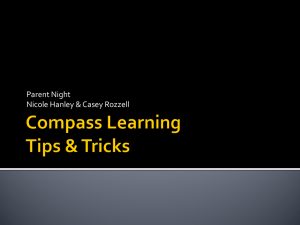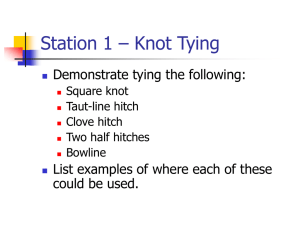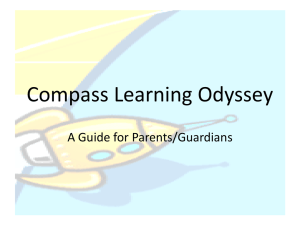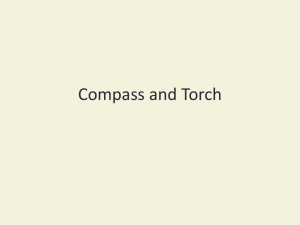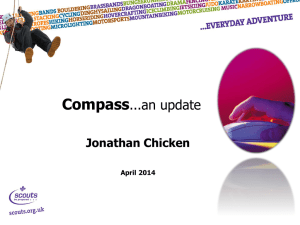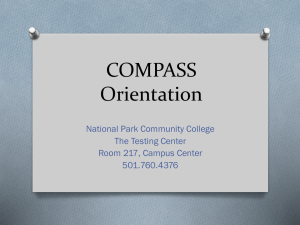Map and Compass Power Point Presentation
advertisement
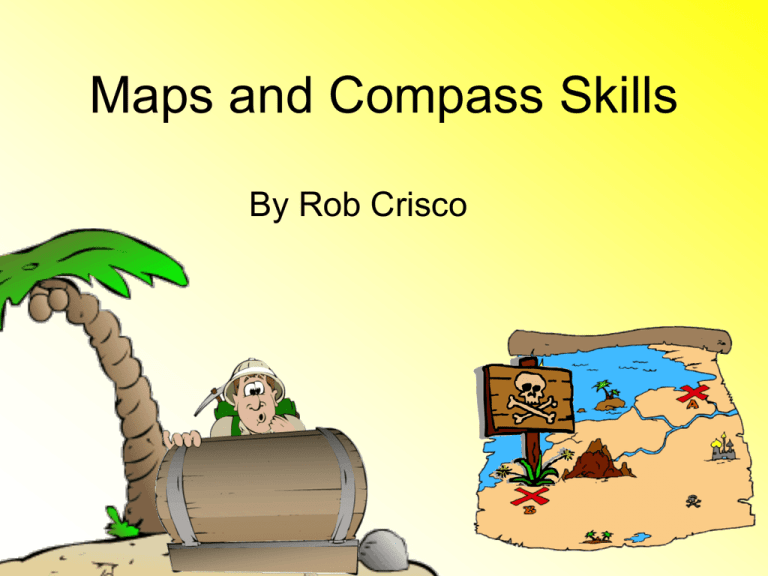
Maps and Compass Skills By Rob Crisco How a Compass Works • Compass operates with a magnetic needle that floats freely on a pivot that points toward magnetic north (an area in Canada that more than a thousand miles away from the North Pole); truenorth (as on maps) points toward the North Pole. • The difference between true north and magnetic north, measured in degree, is called declination. Parts of a Compass Parts of a Compass (cont) • Baseplate - hard, flat surface on which the rest of the compass is mounted. It has a rulers on its edges for measuring distances on maps. It's edge is straight and useful for laying lines on a map • Scales - each edge of a compass may have different rulers for use with different map scales • Direction-of-Travel Arrow - marked on the base plate. You point this the way you will be traveling • Index Pointer - butt end of the direction-of-travel arrow. It ends right at the edge of the dial and is where you take degree readings • Magnifier- for seeing small map features better • Declination Marks - use to orient the compass in an area with known declination Parts of a Compass (cont) • Dial - ring around the housing that has degree markings engraved. You hold the dial and rotate it to rotate the entire housing • Orienting Arrow(Shed) - marked on the floor of the housing. It rotates with the housing when the dial is turned. You use it to orient a compass to a map • Orienting Lines - series of parallel lines marked on the floor of the housing and on the base plate • Needle - magnetized piece of metal that has one end painted red to indicate North. It sits on a fine point that is nearly frictionless so it rotates freely when the compass is held fairly level and steady • Housing - main part of the compass. It is a round plastic container filled with liquid and has the compass needle inside How to read your compass. • Hold your compass steadily in your hand so the base plate is level and the direction-oftravel arrow is pointing straight away from you. • Hold it about halfway between your face and waist in a comfortable arm position with your elbow bent and compass held close to your stomach. • Look down at the compass and see where the needle points. • This compass is pointing due North (also 0 degrees) Exercise • Stand up • Using your compass as an aid, locate southwest • Turn east • Point to the northeast • Now go face west. • Sit down How to Read a Map Directions • • • • North – usually at the top of the map South East West Scale and Distance • Maps are made to scale. There is a direct connection between a unit of measurement and the actual distance. • Example, each inch on a map represents one 1500 feet on Earth. Identify Topographic Symbols Basic Colors: • Black - man-made features such as roads, buildings, etc. • Blue - water, lakes, rivers, streams, etc. • Brown - contour lines – elevation and steepness • Green - areas with substantial vegetation (could be forest, scrub, etc.) • White - areas with little or no vegetation; white is also used to depict permanent snowfields and glaciers • Red - major highways; boundaries of public land areas Topographical Map Symbols Railroad Large Falls/Rapids Mine Woods Topographical Map Symbols Trail Campground / Picnic Area Small Falls/Rapids Glacier Topographical Map Symbols Scrub Highway Lake Sand Camp Rodney Topo Map Compass and Map Simple steps to set your compass. 1. Point baseplate to your destination. 2. Set your heading by turning your dial, until your orienting arrow matches the needle. 3. Follow your heading. Under Stars Finished This power point presentation and instructor notes can be download at ScouterRob.org.

